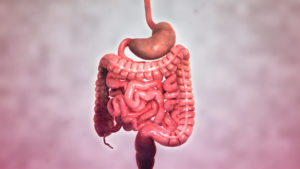Crohn’s disease is a chronic inflammatory disease of the intestines. It primarily causes ulcerations (breaks in the lining) of the small and large intestines, but can affect the digestive system anywhere from the mouth to the anus. It causes a wide variety of symptoms like abdominal pain, diarrhea (even bloody if inflammation is severe), vomiting, weight loss. It may also cause complications outside the gastrointestinal tract such as skin rashes, arthritis, inflammation of the eye, tiredness, and lack of concentration.
Crohn’s disease is related closely to another chronic inflammatory condition that involves only the colon called ulcerative colitis. Together, Crohn’s disease and ulcerative colitis are frequently referred to as Inflammatory bowel disease (IBD).
Crohn’s disease is caused by interactions between environmental, immunological and bacterial factors in genetically susceptible individuals. This result in a chronic inflammatory disorder, in which the body’s immune system attacks the gastrointestinal tract possibly directed at microbial antigens. Crohn’s disease has traditionally been described as an autoimmune disease, but recent investigators have described it as an immune deficiency state.
Many people with Crohn’s disease have symptoms for years prior to the diagnosis. Because of the ‘patchy’ nature of the gastrointestinal disease and the depth of tissue involvement, initial symptoms can be more subtle than those of ulcerative colitis. People with Crohn’s disease experience chronic recurring periods of flare-ups and remission.
Crohn’s disease tends to present initially in the teens and twenties, with another peak incidence in the fifties to seventies, although the disease can occur at any age. Males and females are equally affected. Smokers are two times more likely to develop Crohn’s disease than nonsmokers. Crohn’s disease tends to be more common in relatives of patients with Crohn’s disease. If a person has a relative with the disease, his/her risk of developing the disease is estimated to be at least 10 times that of the general population and 30 times greater if the relative with Crohn’s disease is a sibling.
Treatment options are restricted to controlling symptoms, maintaining remission, and preventing relapse. The disease was named after gastroenterologist Burrill Bernard Crohn, who, in 1932, together with two other colleagues at Mount Sinai Hospital in New York, described a series of patients with inflammation of the terminal ileum, the area most commonly affected by the illness.
The different subtypes of Crohn’s disease are:
- Crohn’s colitis is inflammation that is confined to the colon. Abdominal pain and bloody diarrhea are the common symptoms. Anal fistulae and peri-rectal abscesses also can occur.
- Crohn’s enteritis refers to inflammation confined to the small intestine (the first part, called the jejunum or the second part, called the ileum). Involvement of the ileum alone is referred to as Crohn’s ileitis. Abdominal pain and diarrhea are the common symptoms. Obstruction of the small intestine also can occur.
- Crohn’s terminal ileitis is inflammation that affects only the very end of the small intestine (terminal ileum), the part of the small intestine closest to the colon. Abdominal pain and diarrhea are the common symptoms. Small intestinal obstruction also can occur.
- Crohn’s entero-colitis and ileo-colitis are terms to describe inflammation that involve both the small intestine and the colon. Bloody diarrhea and abdominal pain are the common symptoms. Small intestinal obstruction also can occur.
Crohn’s terminal ileitis and ileo-colitis are the most common types of Crohn’s disease.
Crohn’s disease may also be categorized by the behavior of disease as it progresses.
- Stricturing – causes narrowing of the bowel that may lead to bowel obstruction or changes in the caliber of the feces
- Penetrating – creates abnormal passageways (fistulae) between the bowel and other structures, such as the skin
- Inflammatory – causes inflammation without causing strictures or fistulae
Signs and symptoms
The most common symptoms in Crohn’s disease are those related to the inflammatory damage to the digestive tract.
- Diarrhea – Waxes and wanes; stool may contain mucus, blood, or pus
- Pain in the abdomen – Crampy or steady; in the right lower part of the abdomen or around the belly button; often relieved temporarily by having a bowel movement
- Bloating after eating – Less common, usually seen in cases of bowel obstruction
- Constipation – Usually seen in cases of bowel obstruction
- Pain or bleeding with bowel movement
- Infection of the urinary tract or vagina – Suggests a fistula from the intestinal tract
General symptoms occur in some but not all cases.
- Low-grade fevers
- Weight loss
- Fatigue
Other symptoms of Crohn’s disease may be attributable to related medical conditions affecting the skin, joints, mouth, eyes, liver, and bile ducts.
Many people with Crohn’s disease have symptoms for years prior to the diagnosis. The usual onset is between 15 and 30 years of age, but can occur at any age. Because of the ‘patchy’ nature of the gastrointestinal disease and the depth of tissue involvement, initial symptoms can be more subtle than those of ulcerative colitis. People with Crohn’s disease experience chronic recurring periods of flare-ups and remission.
Abdominal pain may be the initial symptom of Crohn’s disease. It is often accompanied by diarrhea, especially in those who have had surgery. The diarrhea may or may not be bloody. The nature of the diarrhea in Crohn’s disease depends on the part of the small intestine or colon involved. Ileitis typically results in large-volume, watery feces. Colitis may result in a smaller volume of feces of higher frequency. Fecal consistency may range from solid to watery. In severe cases, an individual may have more than 20 bowel movements per day and may need to awaken at night to defecate. Visible bleeding in the feces is less common in Crohn’s disease than in ulcerative colitis, but may be seen in the setting of Crohn’s colitis. Bloody bowel movements are typically intermittent, and may be bright or dark red in color. In the setting of severe Crohn’s colitis, bleeding may be copious. Flatulence and bloating may also add to the intestinal discomfort.
Symptoms caused by intestinal stenosis are also common in Crohn’s disease. Abdominal pain is often most severe in areas of the bowel with stenoses. In the setting of severe stenosis, vomiting and nausea may indicate the beginnings of small bowel obstruction. Although the association is greater in the context of ulcerative colitis, Crohn’s disease may also be associated with primary sclerosing cholangitis, a type of inflammation of the bile ducts, but it is more commonly associated with Ulcerative Colitis.
Perianal discomfort may also be prominent in Crohn’s disease. Itchiness or pain around the anus may be suggestive of inflammation, fistulization or abscess around the anal area or anal fissure. Fecal incontinence may accompany perianal Crohn’s disease. At the opposite end of the gastrointestinal tract, the mouth may be affected by non-healing sores (aphthous ulcers). Rarely, the esophagus, and stomach may be involved in Crohn’s disease. These can cause symptoms including difficulty swallowing (dysphagia), upper abdominal pain, and vomiting.
Crohn’s disease, like many other chronic, inflammatory diseases, can cause a variety of systemic symptoms. Among children, growth failure is common. Many children are first diagnosed with Crohn’s disease based on inability to maintain growth. As it may manifest at the time of the growth spurt in puberty, up to 30% of children with Crohn’s disease may have retardation of growth.
Fever may also be present, though fevers greater than 38.5 ˚C (101.3 ˚F) are uncommon unless there is a complication such as an abscess. Among older individuals, Crohn’s disease may manifest as weight loss, usually related to decreased food intake, since individuals with intestinal symptoms from Crohn’s disease often feel better when they do not eat and might lose their appetite. People with extensive small intestine disease may also have malabsorption of carbohydrates or lipids, which can further exacerbate weight loss.
In addition to systemic and gastrointestinal involvement, Crohn’s disease can affect many other organ systems. Inflammation of the interior portion of the eye, known as Uveitis, can cause eye pain, especially when exposed to light. Inflammation may also involve the white part of the eye (sclera), a condition called Episcleritis. Both Episcleritis and Uveitis can lead to loss of vision if untreated.
Crohn’s disease is associated with a type of rheumatologic disease known as Seronegative Spondyloarthropathy. This group of diseases is characterized by inflammation of one or more joints (Arthritis) or muscle insertions (Enthesitis). The arthritis can affect larger joints, such as the knee or shoulder, or may exclusively involve the small joints of the hands and feet. The arthritis may also involve the spine, leading to Ankylosing Spondylitis if the entire spine is involved or simply Sacroiliitis if only the lower spine is involved. The symptoms of arthritis include painful, warm, swollen, stiff joints and loss of joint mobility or function.
Crohn’s disease may also involve the skin, blood, and endocrine system. One type of skin manifestation, Erythema nodosum, presents as red nodules usually appearing on the shins. Another skin lesion, Pyoderma gangrenosum, is typically a painful ulcerating nodule.
Crohn’s disease also increases the risk of blood clots; painful swelling of the lower legs can be a sign of deep venous thrombosis, while difficulty breathing may be a result of pulmonary embolism. Autoimmune hemolytic anemia, a condition in which the immune system attacks the red blood cells, is also more common in Crohn’s disease and may cause fatigue, pallor, and other symptoms common in anemia. Clubbing, a deformity of the ends of the fingers, may also be a result of Crohn’s disease. Crohn’s disease may cause Osteoporosis (thinning of the bones). Individuals with osteoporosis are at increased risk of bone fractures.
Crohn’s disease can also cause neurological complications (reportedly in up to 15% of patients). The most common of these are seizures, stroke, myopathy, peripheral neuropathy, headache and depression.
Crohn’s patients often also have issues with small bowel bacterial overgrowth syndrome, which has similar symptoms.
In the oral cavity crohn’s patients may suffer from Cheilitis granulomatosa and other forms of orofacial Granulomatosis, Pyostomatitis vegetans, recurrent Aphthous stomatitis, geographic tongue and migratory Stomatitis in higher prevalence than the general population.
Crohn’s disease can lead to several mechanical complications within the intestines, including obstruction, fistulae, and abscesses. Obstruction typically occurs from strictures or adhesions that narrow the lumen, blocking the passage of the intestinal contents. Fistulae can develop between two loops of bowel, between the bowel and bladder, between the bowel and vagina, and between the bowel and skin. Abscesses are walled off collections of infection, which can occur in the abdomen or in the perianal area in Crohn’s disease sufferers.
Crohn’s disease also increases the risk of cancer in the area of inflammation. Individuals with Crohn’s disease involving the small bowel are at higher risk for small intestinal cancer. Similarly, people with Crohn’s colitis have a relative risk of 5.6 for developing colon cancer.
Individuals with Crohn’s disease are at risk of malnutrition for many reasons, including decreased food intake and malabsorption. The risk increases following resection of the small bowel. Such individuals may require oral supplements to increase their caloric intake, or in severe cases, total parenteral nutrition (TPN).
Crohn’s disease can cause significant complications, including bowel obstruction, abscesses, free perforation and hemorrhage.
Crohn’s disease can be problematic during pregnancy, and some medications can cause adverse outcomes for the fetus or mother. In some cases, remission can occur during pregnancy. Certain medications can also impact sperm count or may otherwise adversely affect a man’s ability to conceive.
Crohn’s disease seems to be caused by a combination of environmental factors and genetic predisposition. Researchers believe that in Crohn’s disease the immune system attacks bacteria, foods, and other substances that are actually harmless or beneficial. During this process, white blood cells accumulate in the lining of the intestines, producing chronic inflammation, which leads to ulcers, or sores, and injury to the intestines.
Researchers have found that high levels of a protein produced by the immune system, called tumor necrosis factor (TNF), are present in people with Crohn’s disease. However, researchers do not know whether increased levels of TNF and abnormal functioning of the immune system are causes or results of Crohn’s disease. Research shows that the inflammation seen in the GI tract of people with Crohn’s disease involves several factors: the genes the person has inherited, the person’s immune system, and the environment.
The increased incidence of Crohn’s in the industrialized world indicates an environmental component. Crohn’s is associated with an increased intake of animal protein, milk protein and an increased ratio of omega-6 to omega-3 polyunsaturated fatty acids. Those who consume vegetable proteins appear to have a lower incidence of Crohn’s disease. Smoking increases the risk of the return of active disease (flares). The introduction of hormonal contraception in the United States in the 1960s is associated with a dramatic increase in incidence, and one hypothesis is that these drugs work on the digestive system in ways similar to smoking. Emotional stress is likely to exacerbate Crohn’s.
The diagnosis of Crohn’s disease is suspected in patients with fever, abdominal pain and tenderness, diarrhea with or without bleeding, and anal diseases. Crohn’s disease can be difficult to diagnose because the symptoms are nonspecific.
The following tests may help in the diagnosis:
- Stool tests
- Blood tests
- Biopsy
- Sigmoidoscopy – a short, flexible telescope (sigmoidoscope) is used to investigate the lower bowel
- Colonoscopy – a long, flexible telescope (colonoscope) is used to investigate the colon
- Endoscopy – this can be used if the patient has symptoms in the upper part of his/her gut. A long, thin, flexible telescope (endoscope) goes down through the esophagus into the stomach
- Endoscopic retrograde cholangiopancreatography (ERCP)
- Barium enema X-ray – this involves placing a fluid containing barium (a substance which shows up on X-rays) into the bowel via the rectum. X-ray pictures of the abdomen then show the inside of the bowel more clearly. Barium appears white on X-rays
- Barium contrast studies – for the small intestine a barium meal will be used – the patient will drink barium, a chalky solution that coats the lining of the small intestine, before x rays are taken. The barium appears white on X-rays. The doctor can then see which part of the gut is affected
- Ultrasound, CT and MRI scans
- video capsule endoscopy
Ayurveda Perspective & Management of Crohn's disease

According to Ayurveda, Crohn’s can be compared to ‘Grahani’ disease. Grahani in Ayurveda, is actually an anatomical term to describe small intestines (specifically Ileum and jejunam). Any vitiation or inflammation to this particular part by imbalanced Doshas (Vata, Pitta, Kapha) can cause a wide variety of symptom similar to that of Crohn’s disease, anywhere across the digestive system. Degree and nature of symptoms may vary as per the doshic predominance & involvement.
As per Ayurveda, primary causes of Grahani disease are Mandagi (poor appetite and poor digestion), irregular, improper, irrelevant or incompatible diet habits and junk food. Non-following of the healthy diet habits (Pathya) in certain digestive disorders, especially the conditions of post diarrhea and irritable bowels, are also one of the important causes of this disease.
At CHARAKA, we are providing very effective treatment for Crohn’s disease based on the classical principle of Ayurveda and our research. Treatment involves internal research medicines, strict diet regime and life style modifications. In more severe and chronic cases, Panchakarma therapy is selectively done along with these.
If the patient is already on allopathic treatment, Ayurveda treatment can be clubbed initially and gradually allopathic medicines can be tapered down.
Usually results are very good with Ayurvedic line of treatment. Early cases tend to respond quickly than chronic. If patient can stick to all the guidelines as advised, even complete cure can also be achieved.


